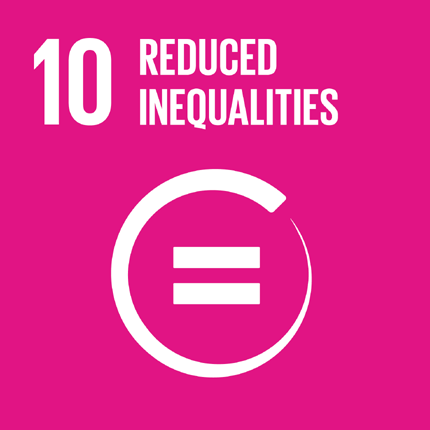sdg10
SUSTAINABLE DEVELOPMENT GOAL 10
Reduce inequality within and among countries
Progress of goal 10
- Goal 10 calls for reducing inequalities in income as well as those based on age, sex, disability, race, ethnicity, origin, religion or economic or other status within a country. The Goal also addresses inequalities among countries, including those related to representation, migration and development assistance.
- Target 10.1 seeks to ensure that income growth among the poorest 40 per cent of the population in every country is more rapid than its national average. This was true in 56 of 94 countries with data available from 2007 to 2012. However, this does not necessarily imply greater prosperity, since nine of those countries experienced negative growth rates over that period.
- The labour share of GDP, which represents the proportion of wages and social protection transfers in an economy, provides an aggregate measure of primary income inequality. A shift of income away from labour towards capital has contributed to rising inequality. Globally, the labour share of GDP decreased from 57 per cent in 2000 to 55 per cent in 2015, mainly owing to stagnating wages and a decline in employers’ social contributions in developed regions, while the trend was stable or slightly upward in developing regions.
- Preferential treatment for developing countries and the least developed countries in trade can help reduce inequalities by creating more export opportunities. Major developed country markets already offer duty-free market access to the least developed countries on most of their tariff lines. But even when they do not, as in the case of some agricultural products, the average applied tariff rate is often close to zero per cent. The share of exports from the least developed countries and developing regions that benefitted from duty-free treatment increased from 2000 to 2014, reaching 79 per cent for developing countries and 84 per cent for the least developed countries. The comparative advantage of the least developed countries in duty-free access varies depending on the product groups analysed. Almost all agricultural products from the least developed countries (98 per cent) were exempt from duties by developed countries, versus 74 per cent of products from developing countries. Shares of exports exempt from duties diverged even more for textiles and clothing: the rate for both product groups for the least developed countries was around 70 per cent, while for developing countries it was 41 per cent for textiles and 34 per cent for clothing.
- Official development assistance and financial flows contribute to reducing inequalities within and among countries. In 2014, total resource flows for development to the least developed countries totalled $55.2 billion, and eight donor countries met the target of 0.15 per cent of gross national income (GNI) for ODA to the least developed countries. Preliminary ODA figures for 2015 show that bilateral net ODA to the least developed countries increased by 4 per cent in real terms, compared to 2014.
- People migrate for many reasons, including better employment opportunities and higher wages. When successful, many migrants send money back to their country of origin to care of family members. Remittances to developing countries have increased slightly, rising to $431.6 billion in 2015, up 0.4 per cent from 2014. In contrast, global remittances (including those to developed countries) were estimated at $582 billion in 2015, a decline of 1.7 per cent from 2014. Even with the global contraction in remittance flows in 2015, the longer term trend is upward. However, the cost of sending money across national borders is significant, averaging 7.5 per cent of the amount remitted in 2015, down from 10 per cent in 2008 but still above the 3 per cent called for in target 10.c.
Source: United Nations, Department of Economic and Social Affairs, SUSTAINABLE DEVELOPMENT KNOWLEDGE PLATFORM
The National Indicators for Sustainable Development Goal 10 are:
- Growth rates of household expenditure or income per capita among the bottom 40 percent of the population and the total population (%)
- Purchasing power adjusted GDP per capita
- Adjusted gross disposable income of households per capita
- Relative median at-risk-of-poverty gap - % distance to poverty threshold
- Income distribution
- Income share of the bottom 40 % of the population - % of income
All available data in .xls file:
Last Updated: 9/5/2025
EU SDG indicator set
To measure SDG achievement in an EU context, an EU SDG indicator set was developed under the leadership of Eurostat. The purpose of this set, which is structured along the 17 global Sustainable Development Goals, is to monitor progress towards the SDGs at the European level.
- For the complete set of indicators available in the Eurostat database, click here.
- To compare Greece’s progress on specific indicators for each Sustainable Development Goal, click here [data visualisation].

